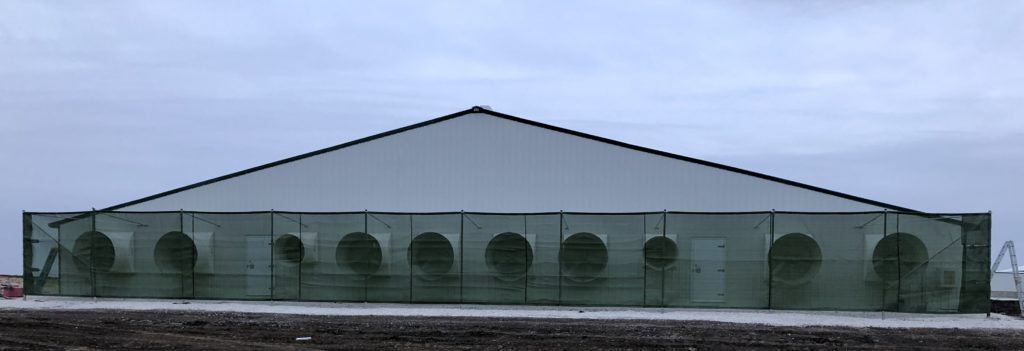Tag: agricultural dust
Ten Reasons to use EPI Air in your Barn
If you are a swine or poultry producer who wants to improve your production rates, it is time to learn about Electrostatic Particle Ionization (EPI) by Baumgartner Environics. EPI is a patented air-cleaning system, specially designed for reducing dust particles from agricultural settings and other confined spaces. Read more about how it works here.
Why use EPI to Improve your In-Barn Air Quality?
- Proven Dust Removal – USDA Studies and other test data show that EPI Air can help remove 50-80% of dust particles and aerosols from the air.
- Improve Animal Production – EPI Air has been shown to dramatically improve animal production and livability (See Murphy-Brown’s production gains).
- Employee Work Environment & Morale – Cleaner air makes it easier for employees to breathe inside the animal production area, creating a better work environment.
- Quick Return on Investment – Murphy-Brown calculated less than 34 weeks to get a ROI based on their own 99.9% statistically significant tests.
- Reduce Odors for Neighbors– EPI Air catches dust particles inside the barn, so gases and pathogens can’t “hitch a ride” on dust particles being emitted outside. Visitors and neighbors will appreciate reduced barn odors.
- Encourage Growth – Cleaner air can also relieve stress on animals, creating an environment that improves the rate of swine and poultry growth.
- Reduce Mortalities – EPI Air has been shown to reduce mortality rates (Mortalities reduced by 26.1% for Murphy-Brown).
- Innovative Combinations – EPI Air can be combined with other clean-air methods such as filtration for promising results.
- Fight PRRS – EPI Air may help PRRS infected pigs to fight secondary complications.
- Worldwide Recognition– EPI Air is installed in barns across the globe. In fact, EPI complies with European standards for dust reduction with Certification in the Netherlands, and also has been invested in by the Canadian government in support of the Manitoba Pork Council.
If you would like to learn more about how EPI Air can make a difference in your production facility, please contact us today.
A Breath of Fresh Air

Recently, Brandi Buzzard, an Agricultural Communicator, Writer, and Scientist who works at Kansas State University, wrote about EPI Air Technology on SwineWeb.com in an article titled “Airing it Out”. At the Animal Science and Industry Department at Kansas State University some of her responsibilities were to coordinate and conduct research trials aimed at developing low stress production practices for swine and cattle producers. Brandi noted, “While I generally enjoy conducting research in swine barns, I must admit that I don’t enjoy what I unaffectionally call ‘hog barn crud’ or the hacking and coughing I experience for the next 2 days after being in the barns.”
What Brandi experienced is the same poor air quality in the barns that swine, poultry or other livestock livein each day. The employees that work in the enclosed swine facilities breathe in the excessive particulate matter in the air, which also contains high levels of ammonia. Needless to say, the dust, gases, and ammonia can be a concern to animals and humans alike. Brandi feels that EPI Air has great possibilities, “ I think it has huge potential to increase herd respiratory health as well as improve the working environment for employees.”
Another student at K-State Swine unit is currently conducting a study to evaluate the effectiveness of the EPI Air system. Although the study is still going on and the results are not available yet, it looks like a promising solution for swine producers. Brandi is excited to hear the results. She explains, “Well, for starters the amount of dust that is removed from the air is astounding. Seeing all that particulate matter stacked on inanimate objects like fences and the walls really opens your eyes to how much dust is flying around in the air and being ingested by both the employees and the animals. If they’re concerned at all about respiratory health for either, they’ll want to consider EPI.”
Brandi is passionate about agriculture and it shows. She writes about it on her blog and on Twitter. Agriculture employs both her family and her husband’s family, and as Brandi says, “It’s our way of life and all we’ve ever known.” Brandi’s philosophy is “I write and speak out and tell my story – if I can help one more person learn about agriculture, then I’ve done my job.”
Understanding PM – Particulate Matter
There is no doubt that poultry houses have high concentrations of agricultural dust inside. According to a recent article in World Poultry.net, much of the dust in poultry barns comes from the litter and manure, down feathers, mineral crystals in urine, and feed. The article, Chickens: Negative air ionisation strongly decreases fine dust, goes on to explain how the concentration of dust inside poultry houses is directly related to the activity of the birds during light periods, especially in litter housing systems like floor housing for broilers and layers, and aviary housing for layers.
Dust is PM – Particulate Matter
High concentrations of dust are often referred to as “Particulate Matter” or PM. The concentration of PM is measured in terms of their size in diameter in micrometers. According to the EPA, the size of dust particles is directly linked to their potential for causing health problems.
PM 10
Dust or particulate matter with a size smaller than or equal to 10 micrometer in diameter, but larger then 2.5 micrometers in diameter, are often referred to as “inhalable coarse particles.” This particulate matter can be found near roadways and dusty industries, but also in some livestock barns.
PM 2.5
Very fine dust fraction or particulate matter below 2.5 micrometers are often referred to as “fine particles,” such as those emitted from forest fires, automobiles, and some agricultural settings. Particulate matter of 2.5 or smaller are able to pass the nose, mouth and larynx, penetrate into the thorax and some even into the lung tissues, causing adverse respiratory and cardiovascular health effects.
How to Remove Dust from Barns
Agricultural research teams have been working on developing technology for the reduction of dust exposure in poultry facilities. One such technology is EPI Air, which uses electrostatic particle ionization to emit electrons that charge dust particles that are in the air. The negatively charged particles then collect on the grounded surfaces in the barn, which is cleaned like normal after the growing cycle is complete. Studies by Murphy-Brown have shown significant reduction in particulate matter (57.7% reduction of 10-micron size, 47.4% reduction of 2.5 micron size, 43.1% reduction of .05 micron size) as well as a variety of production gains.
Contact Baumgartner Environics today to learn more about removing agricultural dust with EPI Air.
How to Clean a Barn with EPI Installed
Often we hear questions from customers regarding how to clean a barn that has the EPI Air® System installed. The answer is basically “Clean the barn like usual,” but here are a few things to remember.
Think Differently about Dust
 The EPI Air® System requires a bit of a paradigm shift regarding room cleanliness, since a thick layer of visible dust will collect on surfaces in the barn. It is important to remember that dust collected on surfaces is superior to dust suspended in the breathable air. Even though the dust will be more noticeable on these surfaces, removing dust from the air enhances ventilation and data shows that it improves production.
The EPI Air® System requires a bit of a paradigm shift regarding room cleanliness, since a thick layer of visible dust will collect on surfaces in the barn. It is important to remember that dust collected on surfaces is superior to dust suspended in the breathable air. Even though the dust will be more noticeable on these surfaces, removing dust from the air enhances ventilation and data shows that it improves production.
Clean the Barn like Usual
When the animal production phase has been completed, the room can be cleaned as part of normal barn washing operations. The EPI Air® components can be power-washed when the system is powered off. A handheld leaf blower also works well to remove the collected dust from the surfaces to get them out of the barn. Turn the fans on to purge and blow the dust off barn surfaces. Dust is also removed easily by sweeping with a broom or rapping on the surfaces with a rubber mallet.
What other questions do you have about cleaning a barn with the EPI® System installed?
“Today in America” features EPI (Video)
EPI was recently featured in “Today in America”, with a video hosted by Terry Bradshaw. “Today in America” headlines innovative products and news from businesses, inventors, and leaders across the United States. John and Matt Baumgartner of Baumgartner Environics, and Steve Pollman and Chris Rademacher of Murphy-Brown LLC explain how EPI (Electrostatic Particle Ionization) results in cleaner, healthier air, providing a better work environment for all involved including animals and workers alike.

If you would like to learn more about how EPI could benefit your livestock, call Baumgartner Environics at 800-823-4234, fill out this simple form, or comment below.

